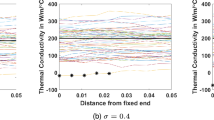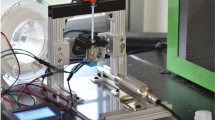Abstract
In this study, a numerical framework based on the material point method is presented for the simulation of material extrusion (MEX)-based 3-D printing processes. The melt flow during material extrusion is assumed to be viscous flow including phase changes. To apply the free surface boundary conditions, the framework utilizes the level set method to track the free surface and the ghost fluid method for the application of the boundary conditions. For validation, three representative problems are first investigated to show the versatility of the model. Then, the numerical framework is adapted for the simulation of material extrusion (MEX) based 3-D printing processes. An in-depth parametric study is presented to show how printing parameters affect the overall extruded printing material.













Similar content being viewed by others
References
dell’Isola, F., Seppecher, P., Spagnuolo, M., Barchiesi, E., Hild, F., Lekszycki, T., Giorgio, I., Placidi, L., Andreaus, U., Cuomo, M., et al.: Advances in pantographic structures: Design, manufacturing, models, experiments and image analyses. Continuum Mech. Thermodyn. 31, 1231–1282 (2019)
dell’Isola, F., Giorgio, I., Pawlikowski, M., Rizzi, N.L.: Large deformations of planar extensible beams and pantographic lattices: heuristic homogenization, experimental and numerical examples of equilibrium. In: Proceedings of the Royal Society A: Mathematical, Physical and Engineering Sciences 472(2185), 20150790 (2016)
Turco, E., dell’Isola, F., Cazzani, A., Rizzi, N.L.: Hencky-type discrete model for pantographic structures: Numerical comparison with second gradient continuum models. Z. Angew. Math. Phys. 67, 1–28 (2016)
Golaszewski, M., Grygoruk, R., Giorgio, I., Laudato, M., Cosmo, F.D.: Metamaterials with relative displacements in their microstructure: Technological challenges in 3d printing, experiments and numerical predictions. Continuum Mech. Thermodyn. 31, 1015–1034 (2019)
Turco, E., Barchiesi, E., Giorgio, I., dell’Isola, F.: A lagrangian hencky-type non-linear model suitable for metamaterials design of shearable and extensible slender deformable bodies alternative to timoshenko theory. Int. J. Non-Linear Mech. 123, 103481 (2020)
Turco, E., Barchiesi, E., dell’Isola, F.: Nonlinear dynamics of origami metamaterials: Energetic discrete approach accounting for bending and in-plane deformation of facets. Z. Angew. Math. Phys. 74(1), 26 (2023)
Guo, N., Leu, M.C.: Additive manufacturing: Technology, applications and research needs. Front. Mech. Eng. 8(3), 215–243 (2013)
Gao, W., Zhang, Y., Ramanujan, D., Ramani, K., Chen, Y., Williams, C.B., Wang, C.C., Shin, Y.C., Zhang, S., Zavattieri, P.D.: The status, challenges, and future of additive manufacturing in engineering. Comput. Aided Des. 69, 65–89 (2015)
Huang, Y., Leu, M.C., Mazumder, J., Donmez, A.: Additive manufacturing: Current state, future potential, gaps and needs, and recommendations. J. Manuf. Sci. Eng. 137(1), 014001 (2015)
Bikas, H., Stavropoulos, P., Chryssolouris, G.: Additive manufacturing methods and modelling approaches: A critical review. Int. J. Adv. Manuf. Technol. 83(1–4), 389–405 (2016)
Bellini, A., Güçeri, S.: Mechanical characterization of parts fabricated using fused deposition modeling. Rapid Prototyp. J. 9(4), 252–264 (2003)
Zhang, Y., Chou, Y.: Three-dimensional finite element analysis simulations of the fused deposition modelling process. Proc. Inst. Mech. Eng. Part B J. Eng. Manuf. 220(10), 1663–1671 (2006)
Kantaros, A., Karalekas, D.: Fiber bragg grating based investigation of residual strains in abs parts fabricated by fused deposition modeling process. Mater. Des. 50, 44–50 (2013)
Peng, A., Xiao, X., Yue, R.: Process parameter optimization for fused deposition modeling using response surface methodology combined with fuzzy inference system. Int. J. Adv. Manuf. Technol. 73(1–4), 87–100 (2014)
Hwang, S., Reyes, E.I., Moon, K.-S., Rumpf, R.C., Kim, N.S.: Thermo-mechanical characterization of metal/polymer composite filaments and printing parameter study for fused deposition modeling in the 3D printing process. J. Electron. Mater. 44(3), 771–777 (2015)
Xia, H., Lu, J., Dabiri, S., Tryggvason, G.: Fully resolved numerical simulations of fused deposition modeling. part i-fluid flow. arXiv preprint arXiv:1711.05940 (2017)
Xia, H., Lu, J., Tryggvason, G.: Fully resolved numerical simulations of fused deposition modeling. part ii-solidification, residual stresses, and modeling of the nozzle. arXiv preprint arXiv:1711.07094 (2017)
Comminal, R., Serdeczny, M.P., Pedersen, D.B., Spangenberg, J.: Numerical modeling of the strand deposition flow in extrusion-based additive manufacturing. Addit. Manuf. 20, 68–76 (2018)
Fitzharris, E.R., Watanabe, N., Rosen, D.W., Shofner, M.L.: Effects of material properties on warpage in fused deposition modeling parts. Int. J. Adv. Manuf. Technol. 95(5–8), 2059–2070 (2018)
Özen, A., Abali, B.E., Völlmecke, C., Gerstel, J., Auhl, D.: Exploring the role of manufacturing parameters on microstructure and mechanical properties in fused deposition modeling (FDM) using PETG. Appl. Compos. Mater. 28(6), 1799–1828 (2021)
Özen, A., Ganzosch, G., Barchiesi, E., Auhl, D.W., Müller, W.H.: Investigation of deformation behavior of PETG-FDM-printed metamaterials with pantographic substructures based on different slicing strategies. Compos. Adv. Mater. 30, 26349833211016476 (2021)
Sulsky, D., Chen, Z., Schreyer, H.L.: A particle method for history-dependent materials. Comput. Methods Appl. Mech. Eng. 118(1–2), 179–196 (1994)
Sulsky, D., Zhou, S.-J., Schreyer, H.L.: Application of a particle-in-cell method to solid mechanics. Comput. Phys. Commun. 87(1–2), 236–252 (1995)
York, A.R., Sulsky, D., Schreyer, H.L.: Fluid-membrane interaction based on the material point method. Int. J. Numer. Meth. Eng. 48(6), 901–924 (2000)
Gilmanov, A., Acharya, S.: A hybrid immersed boundary and material point method for simulating 3d fluid-structure interaction problems. Int. J. Numer. Meth. Fluids 56(12), 2151–2177 (2008)
Bardenhagen, S., Brackbill, J., Sulsky, D.: The material-point method for granular materials. Comput. Methods Appl. Mech. Eng. 187(3–4), 529–541 (2000)
Schreyer, H., Sulsky, D., Zhou, S.-J.: Modeling delamination as a strong discontinuity with the material point method. Comput. Methods Appl. Mech. Eng. 191(23–24), 2483–2507 (2002)
Zhang, D.Z., Zou, Q., VanderHeyden, W.B., Ma, X.: Material point method applied to multiphase flows. J. Comput. Phys. 227(6), 3159–3173 (2008)
Zhang, H., Wang, K., Chen, Z.: Material point method for dynamic analysis of saturated porous media under external contact/impact of solid bodies. Comput. Methods Appl. Mech. Eng. 198(17–20), 1456–1472 (2009)
Li, F., Pan, J., Sinka, C.: Modelling brittle impact failure of disc particles using material point method. Int. J. Impact Eng 38(7), 653–660 (2011)
Lian, Y., Zhang, X., Zhou, X., Ma, S., Zhao, Y.: Numerical simulation of explosively driven metal by material point method. Int. J. Impact Eng 38(4), 238–246 (2011)
Burghardt, J., Brannon, R., Guilkey, J.: A nonlocal plasticity formulation for the material point method. Comput. Methods Appl. Mech. Eng. 225, 55–64 (2012)
Chen, Z., Jiang, S., Gan, Y., Liu, H., Sewell, T.D.: A particle-based multiscale simulation procedure within the material point method framework. Comput. Part. Mech. 1(2), 147–158 (2014)
Zhang, F., Zhang, X., Sze, K.Y., Lian, Y., Liu, Y.: Incompressible material point method for free surface flow. J. Comput. Phys. 330, 92–110 (2017)
Bardenhagen, S., Kober, E.: The generalized interpolation material point method. Comput. Model. Eng. Sci. 5(6), 477–496 (2004)
Sadeghirad, A., Brannon, R.M., Burghardt, J.: A convected particle domain interpolation technique to extend applicability of the material point method for problems involving massive deformations. Int. J. Numer. Meth. Eng. 86(12), 1435–1456 (2011)
Gan, Y., Sun, Z., Chen, Z., Zhang, X., Liu, Y.: Enhancement of the material point method using B-spline basis functions. Int. J. Numer. Meth. Eng. 113(3), 411–431 (2018)
Chorin, A.J.: Numerical solution of the Navier–Stokes equations. Math. Comput. 22(104), 745–762 (1968)
Russo, G., Smereka, P.: A remark on computing distance functions. J. Comput. Phys. 163(1), 51–67 (2000)
Giorgio, I.: A variational formulation for one-dimensional linear thermoviscoelasticity. Math. Mech. Complex Syst. 9(4), 397–412 (2022)
Chen, L.: Using the generalized interpolation material point method for fluid-solid interactions induced by surface tension. PhD thesis, University of Alaska Fairbanks (2013)
Acknowledgements
M. E. Yildizdag gratefully acknowledges the financial support from The Scientific and Technological Research Council of Turkey (TUBITAK), under the scholarship program BIDEB 2213.
Author information
Authors and Affiliations
Corresponding author
Additional information
Publisher's Note
Springer Nature remains neutral with regard to jurisdictional claims in published maps and institutional affiliations.
Rights and permissions
Springer Nature or its licensor (e.g. a society or other partner) holds exclusive rights to this article under a publishing agreement with the author(s) or other rightsholder(s); author self-archiving of the accepted manuscript version of this article is solely governed by the terms of such publishing agreement and applicable law.
About this article
Cite this article
Yildizdag, M.E. Numerical modeling and simulation of material extrusion-based 3-D printing processes with a material point method framework. Continuum Mech. Thermodyn. (2023). https://doi.org/10.1007/s00161-023-01273-1
Received:
Accepted:
Published:
DOI: https://doi.org/10.1007/s00161-023-01273-1




